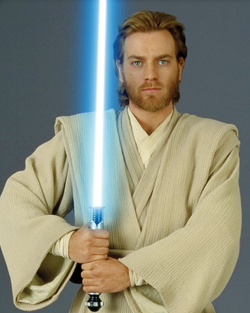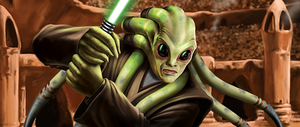| | |
Form I, also known as Shii-Cho, The Way of the Sarlacc, or The Determination Form, was the oldest and most rudimentary form of lightsaber combat developed by the Jedi Order and was taught to all members of the Jedi Order. After the creation of other combat styles, the first form was often used when all the others had failed.
Description[]

Obi-Wan Kenobi adopts a Form I stance.
Form I was the most ancient lightsaber form still in use at the time of the Jedi's fall. In fact, it was the first form created, codifying standard lightsaber techniques in the early centuries of the Jedi Order. Compared with the forms developed later, Shii-Cho was direct, even simplistic. The philosophy and techniques of this basic and traditional approach remained effective and it was undeniably potent in the hands of a master.[2]
The origins of Shii-Cho were murky, an unavoidable consequence of the nearly inconceivable amount of time that had passed since its inception. While it was possible that what would become Shii-Cho was originally seen as the only effective or proper way to wield a lightsaber, it was also possible that it was but one of several disciplines then in use, the one that ultimately would win out in popularity and efficacy. It was likely that Shii-Cho represented the synthesis of several styles of lightsaber combat that arose concurrently. Regardless, Shii-Cho as it was known in the last days of the Jedi Order was established as a distinct style within the first millennium of the Jedi's existence. The early Jedi, and perhaps even their precursors, adapted the fighting style that would become Shii-Cho from existing swordplay techniques. These traditional maneuvers primarily focused on direct blows intended to kill or maim, and their results were amplified by the unprecedented efficacy of the lightsaber.[2]
As the early Jedi saw the spiritual dangers inherent in such aggressive techniques and deadly intent, they attempted to balance their nascent lightsaber combat style with an increased focus on disarming the foe. It proved quite easy to disarm most opponents, since few weapons could resist a lightsaber strike. In fact, lightsaber-wielding Jedi were at such an advantage against foes armed with traditional melee weapons that Shii-Cho developed alongside a philosophy that advocated "the defeat of a foe without inflicting serious injury is the highest form of victory". This concept, so integral to Shii-Cho, became almost inseparable from the overall philosophy of the Jedi and their purpose as peacekeepers.[2]
Although later forms sought to address the weaknesses of Shii-Cho, they didn't supplant the style entirely. Its relative simplicity ensured that Form I remained a popular form for Padawans throughout their training and full Jedi Knights continued to practice the form throughout the order's history. For Jedi with full command of multiple forms, Form I often served as a last resort when others failed, or in situations that rendered more specialized forms impractical. Other Jedi included Form I techniques in their standard repertoire, employing them alongside maneuvers from other forms in order to minimize the weaknesses of Shii-Cho.[2]
Even into the last days of the Galactic Republic, Form I had its advocates. During the Clone Wars, Shii-Cho experienced a resurgence among Jedi fighting on the front lines. The B1-series battle droids and other rank-and-file units of the Confederacy military proved highly vulnerable to the direct and aggressive approach to Form I due to their relatively slow reactions, predictable programming and lack of defenses against lightsabers. In a way the simplicity of the form offered a perfect counter to the battle droids' dismally blunt approach to combat. However, Jedi who favored Form I in the battles against the Separatist Droid Army usually tempered it with defensive maneuvers from Form III and Form V to deal with the high volume of blaster fire.[2]
Shii-Cho in practice[]

Kit Fisto was a master of Form I.
Shii-Cho favored a direct approach to combat that strongly resembled that of traditional sword-fighting of the sort still practiced by warriors throughout the galaxy wielding monomolecular-edged blades and vibroswords. The strikes and broad parries of Form I were quite basic in comparison to the sophisticated Force-empowered maneuvers of other forms. However, this relative simplicity ensured that Form I was viable in a variety of situations if perhaps less effective than a more specialized form.[2]
Because it favored direct attacks over the acrobatic mobility of Form IV and the Force powers of Form VI, Shii-Cho might have appeared more aggressive than other forms. However, this appearance was misleading. Far from the violent Form VII, Shii-Cho required a calm and collected, even methodical application. Practitioners of the form attacked frequently in order to take advantage of any opening the foe presented, or to force one when necessary. However, Form I users always returned to a defensive stance after each strike, and made extensive use of parries. In this way, the form maintained a consistent but flexible balance between defense and offense.[2]
One notable deviation of Form I from traditional sword-fighting techniques was in the use of wide, sweeping motions to strike multiple opponents. Such maneuvers were considered to be impractical, even foolish when wielding an ordinary blade. Even a skilled user with a keen-edged weapon took an extreme gamble in making an attempt, as failure left them open to a counterattack. Trying to cut through layers of armor, flesh, and bone both slowed a standard blade and altered its trajectory. A lightsaber did not face these issues, as its blade could slice through a theoretically limitless quantity of material without any loss of cutting power.[2]
Appearances[]
- Star Wars: Episode II Attack of the Clones (First appearance)
Sources[]
 Star Wars: Card Trader (Card: Magnaguard - Separatists - Base Series 1) (Indirect mention only)
Star Wars: Card Trader (Card: Magnaguard - Separatists - Base Series 1) (Indirect mention only)- Star Wars: Absolutely Everything You Need to Know (First identified as Form I and Shii-Cho)
 Star Wars: Build the Millennium Falcon 59 (Secrets of Spaceflight: Training Remotes)
Star Wars: Build the Millennium Falcon 59 (Secrets of Spaceflight: Training Remotes)- Star Wars: The Visual Encyclopedia
- Star Wars: Lightsaber Battles
- Knights of Fate (First identified as Way of the Sarlacc) (First identified as The Determination Form)
 Across the Galaxy on Fantasy Flight Games' official website (backup link)
Across the Galaxy on Fantasy Flight Games' official website (backup link)"Lightsabers and Jedi Equipment" — Star Wars Encyclopedia

